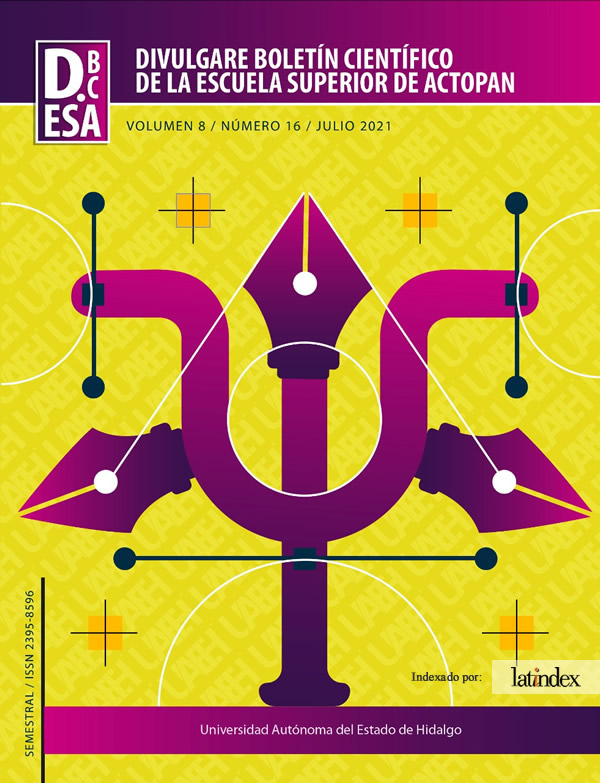Personality and affective state in people with normo and hypertension
Abstract
A pilot study was conducted with 8 people with hypertension under pharmacological treatment, outpatients of the General Hospital of Pachuca, and 8 volunteers with blood pressure within normal parameters. Measurements of systolic and diastolic blood pressure, body mass index, personality and affective status were taken. No statistically significant differences were found in four of the 5 personality factors, except for the neuroticism factor, which had a higher level in the group with hypertension. The negative and positive affective state was equivalent in both groups. These results are a guide for future research and interventions that aim to promote comprehensive health in patients with hypertension.
Downloads
References
Cheng, H., Montgomery, S., Treglown, L., Furnham, A. (2017). Emotional stability, conscientiousness, and self-reported hypertension in adulthood. Pers Individ Dif. http://dx.doi.org/10.1016/j.paid.2016.02.034
Costa, M. T., Mcrae, R. R. (1992). Revised NEO Inventory: Professional manual. Psychological Assessment Resources.
Cuffee, Y., Ogedegbe, C., Williams, N. J., Ogedegbe, G., Schoenthaler, A. (2014). Psychosocial Risk Factors for Hypertension: an Update of the Literature.
Espinoza-Gómez, F., Ceja-Espíritu, G., Trujillo-Hernández, B., Uribe-Araiza, T., Abarca-de Hoyos, P., Flores-Vázquez, D. (2003). Analysis of risk factors for hypertension in Colima, Mexico. Revista panamericana de salud pública.
European Society of Cardiology (2018). 2018 ESC/ESH Clinical Practice Guidelines for the Management of Arterial Hypertension. https://doi.org/10.1093/eurheartj/ehy339
Fusté-Escolano, A. (2009). Comportamiento y salud. MANUAL DE PSICOLOGÍA CLÍNICA Y DE LA SALUD HOSPITALARIA.
Hervás, G., Vázquez, C. (2006). La regulación afectiva: Modelos, investigación e implicaciones para la salud mental y física. Revista de psicología general y aplicada.
Hill, L. K., Thayer, J. F. (2019). The Autonomic Nervous System and Hypertension : Ethnic Differences and Psychosocial Factors.
Instituto Nacional de Salud Pública [INSP] (2018), “Encuesta Nacional de Salud y Nutrición 2018”. Disponible en: https://ensanut.insp.mx/encuestas/ensanut2018/doctos/informes/ensanut_2018_presentacion_resultados.pdf
Jenkins, C. D., Rosenman, R. H., Friedman, M. (1967). Development of an objective psychological test for the determination of the coronary-prone behavior pattern in employed men. Journal of Chronic Diseases.
Mommersteeg, P. M. (2011). Type D personality and metabolic syndrome in a 7 year prospective occupational cohort. J Psychosom Res, 71(5).
Moral de la Rubia, J. (2011). La escala de afecto positivo y negativo (PANAS) en parejas casadas mexicanas. Ciencia Ergo Sum, 18(2), 117-125.
Moreno, A., Caro, L., Rodríguez-Roca, G. C., Prieto-Díaz, M. A., División-Garrote, J. A. (2010). Conducta del médico de atención primaria ante el mal control de la hipertensión arterial Estudio PRESCAP 2010. SEMERGEN-Medicina de familia, 39(1).
Moreno, M., Contreras, D., Martínez, N., Araya, P., Livacic-Rojas, P., Vera-Villarroel, P. (2006). Effects of a cognitive-behavioral intervention on blood pressure of hypertensive elderly subjects. Revista médica de Chile.
O’Donnell, M. J., Chin, S. L., Rangarajan, S., Xavier, D., Liu, L.,Zhang. H-, et al. Global and regional effects of potentially modifiable risk factors associated with acute stroke in 32 countries (INTERSTROKE): a case-control study. Lancet [Internet]. 2016;388(10046):761–75. Available from: http://dx.doi.org/10.1016/S0140-6736(16)30506-2
Ortiz, F. (2006). Replicabilidad del modelo de los cinco grandes y la asertividad en México. Revista electrónica de Psicología Iztacala, 9(1).
Pal, G. K., Adithan, C., Amudharaj, D., Dutta, T. K., Pal, P., Nandan, P. G. (2011). Assessment of sympathovagal imbalance by spectral analysis of heart rate variability in prehypertensive and hypertensive patients in indian population. Clin Exp Hypertens, 33(7).
Pérez-Díaz, J., Guerra-Morales, M., Zamora-Fleites, Y., Grau-Ábalo, R. (2013). Regulación emocional en adolescentes con hipertensión arterial esencial. Revista Cubana de Medicina.
Riveros, A. , Ceballos, G., Laguna, R. (2005). El manejo psicológico de la hipertensión esencial: efectos de una intervención cognitivo-conductual. Revista Latinoamericana de Psicología, 37 (3).
Schultz, D. P. (2006). Teorías de las personalidad. México: Thomson.
Turiano, N. A. (2012). Personality trait level and change as predictors of health outcomes: findings from a national study of Americas. J Gerontol Ser B Psychol Sci Soc Sci, 61(1).
Zamora-Fleites, Y. (2013).Caracterización de la regulación emocional en pacientes de 12 a 15 años con hipertensión arterial esencial (tesis de pregrado). Universidad Central “Marta Abreu de las Villas”, Santa Clara, Cuba.











